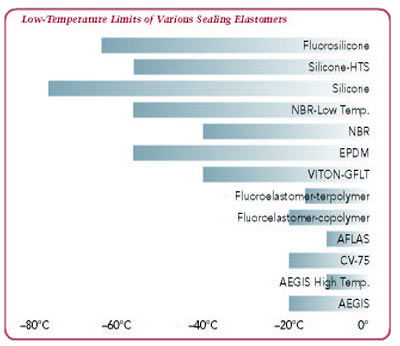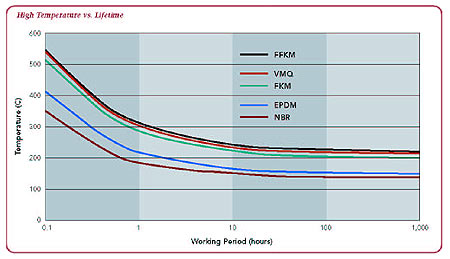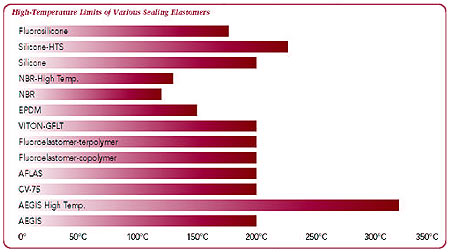
|
7108
S. Alton Way, Unit I |
(303) 758-2728
Home > Elastomer Properties > Thermal Stability
Seal Thermal Stability
Low Temperature Seal Thermal Stability
The low-temperature limit is generally 15°F below TR-10 for static seals. For dynamic seals the TR-10 is more relevant. The TR-10 is the temperature at which an elastomer is able to retract 10%.
Low-temperature performance is generally a reversible process.
For design purposes compression is generally increased. The chemical media may cause swelling which may act as a plasticizer and lower the service temperature.
Definition of:
Glass Transition Temperature:

Thermal Expansion
| Material | Units | Therm. Stab. | x10–5 /°C |
x10–6 /°F |
| FKM | 200°C | 16 | 90 | |
| NBR | 120°C | 23 | 62 | |
| VMQ | 230°C | 59–79 | 103 | |
| FFKM | 300°C | 23 | ||
| EPDM | 150°C | 16 | ||
| Stainless | – | 1.04 | ||
| Aluminum | – | 1.3 | ||
| TFE and FEP | 230°C | 5–8 | ||
| KEL-F | 280°C | 4–7 | ||
| Polyimide | 275°C | 5 |
| Thermal
Conductivity (g-cal/sec/cm2/cm/C) |
Specific
Heat (cal/g/C) |
|
| VMQ | 0.330–0.515 x 10–3 | 0.28–0.35 |
| SC1030/SC1020 | 0.6/0.8 x 10–3 | 0.2 |
High Temperature Seal Thermal Stability
The high-temperature limit for seal thermal stability is generally considered a 30–50% loss of physical properties and typically represents a maximum temperature for 1,000 hours continuous service. It represents an irreversible change in the backbone or cross-link network.
The effect of high temperature can be compounded by the interaction with the chemical media. Chemical reactions typically double with a 10°C increase in temperature.
Definition of:
- Thermal Conductivity: ASTM C177, C518
- Thermal Expansion: ASTM D864
- Heat Aging: ISO 188, ASTM D454, D572, D573, D865


Viton® was a registered trademark of DuPont at the time the article was written and is now a registered trademark of the Chemours Company.
Next topic Chemical Seal: Chemical Compatibility
We are located in the Denver Technological
Center in a suburb of Denver, Colorado
©1997-2017, Problem Solving Products, Inc.
Website Map | Privacy Statement
| Terms of Use

